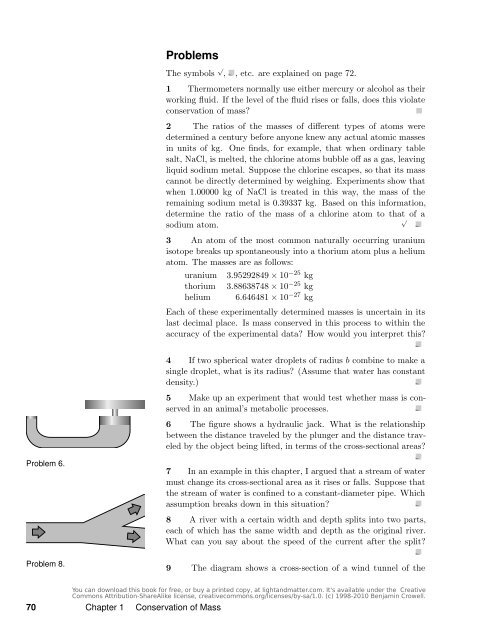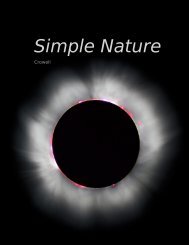Chapter 1 Conservation of Mass - Light and Matter
Chapter 1 Conservation of Mass - Light and Matter
Chapter 1 Conservation of Mass - Light and Matter
Create successful ePaper yourself
Turn your PDF publications into a flip-book with our unique Google optimized e-Paper software.
Problem 6.<br />
Problem 8.<br />
70 <strong>Chapter</strong> 1 <strong>Conservation</strong> <strong>of</strong> <strong>Mass</strong><br />
Problems<br />
The symbols √<br />
, , etc. are explained on page 72.<br />
1 Thermometers normally use either mercury or alcohol as their<br />
working fluid. If the level <strong>of</strong> the fluid rises or falls, does this violate<br />
conservation <strong>of</strong> mass?<br />
2 The ratios <strong>of</strong> the masses <strong>of</strong> different types <strong>of</strong> atoms were<br />
determined a century before anyone knew any actual atomic masses<br />
in units <strong>of</strong> kg. One finds, for example, that when ordinary table<br />
salt, NaCl, is melted, the chlorine atoms bubble <strong>of</strong>f as a gas, leaving<br />
liquid sodium metal. Suppose the chlorine escapes, so that its mass<br />
cannot be directly determined by weighing. Experiments show that<br />
when 1.00000 kg <strong>of</strong> NaCl is treated in this way, the mass <strong>of</strong> the<br />
remaining sodium metal is 0.39337 kg. Based on this information,<br />
determine the ratio <strong>of</strong> the mass <strong>of</strong> a chlorine atom to that <strong>of</strong> a<br />
√<br />
sodium atom.<br />
3 An atom <strong>of</strong> the most common naturally occurring uranium<br />
isotope breaks up spontaneously into a thorium atom plus a helium<br />
atom. The masses are as follows:<br />
uranium 3.95292849 × 10 −25 kg<br />
thorium 3.88638748 × 10 −25 kg<br />
helium 6.646481 × 10 −27 kg<br />
Each <strong>of</strong> these experimentally determined masses is uncertain in its<br />
last decimal place. Is mass conserved in this process to within the<br />
accuracy <strong>of</strong> the experimental data? How would you interpret this?<br />
4 If two spherical water droplets <strong>of</strong> radius b combine to make a<br />
single droplet, what is its radius? (Assume that water has constant<br />
density.)<br />
5 Make up an experiment that would test whether mass is conserved<br />
in an animal’s metabolic processes.<br />
6 The figure shows a hydraulic jack. What is the relationship<br />
between the distance traveled by the plunger <strong>and</strong> the distance traveled<br />
by the object being lifted, in terms <strong>of</strong> the cross-sectional areas?<br />
7 In an example in this chapter, I argued that a stream <strong>of</strong> water<br />
must change its cross-sectional area as it rises or falls. Suppose that<br />
the stream <strong>of</strong> water is confined to a constant-diameter pipe. Which<br />
assumption breaks down in this situation?<br />
8 A river with a certain width <strong>and</strong> depth splits into two parts,<br />
each <strong>of</strong> which has the same width <strong>and</strong> depth as the original river.<br />
What can you say about the speed <strong>of</strong> the current after the split?<br />
9 The diagram shows a cross-section <strong>of</strong> a wind tunnel <strong>of</strong> the














